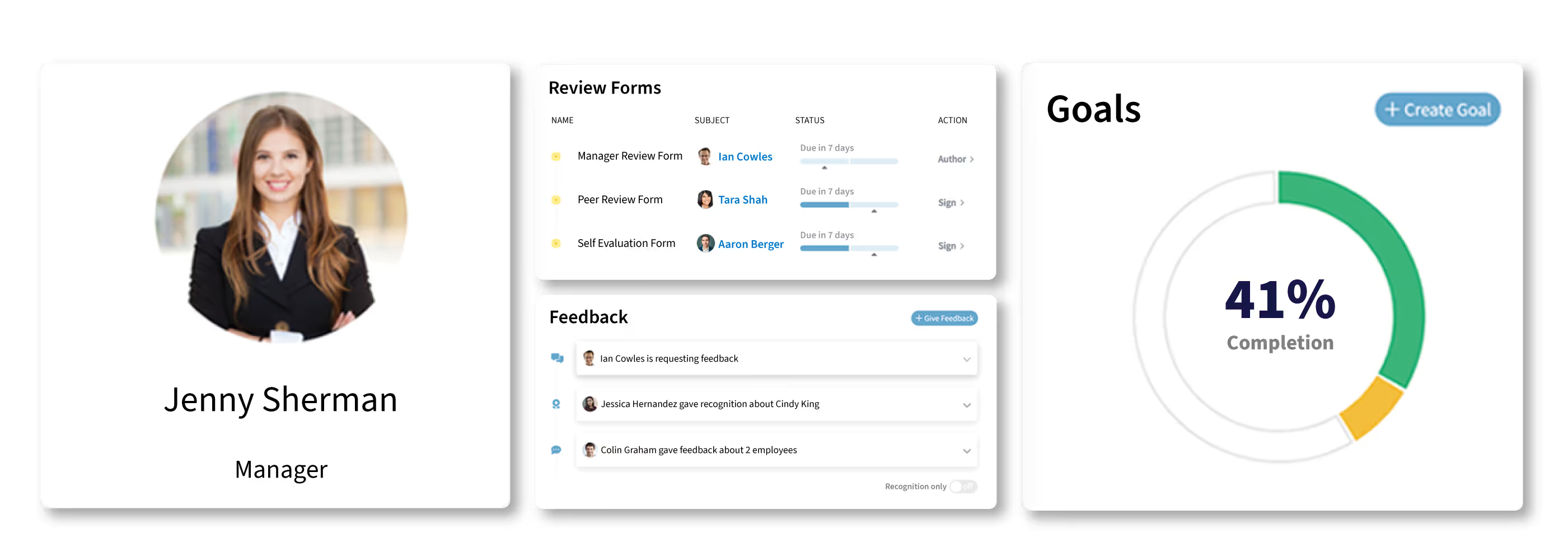2025 State of Performance Management Report
A comprehensive analysis of trends, best practices, and organizational impact.

Performance Management
Effective Performance Management requires balancing detailed reviews with active employee engagement.
Our comprehensive analysis of anonymized PerformYard data from 2000+ organizations across all industries and company sizes reveals key insights about what works best in different company contexts.
This report explores how review form length, feedback culture, qualitative questions, and company characteristics impact critical metrics like completion rates, engagement scores, and goal achievement. We'll also examine industry-specific trends and the evolution of performance management over time.
By understanding these patterns, you can optimize your performance management approach to drive better outcomes for both employees and your organization.

Data-Driven Insights
Foundation for effective decisions

Feedback Culture
Continuous improvement cycle

Goal Alignment
Strategic direction and focus

Company Growth
Organizational success outcome
Table of Contents
Learn how review, design, manager span of control, and industry-specific practices influence engagement, goal completion, and company growth.
Review Form Design
Finding the Sweet Spot
Review Completion % by Number of Questions on Review Form
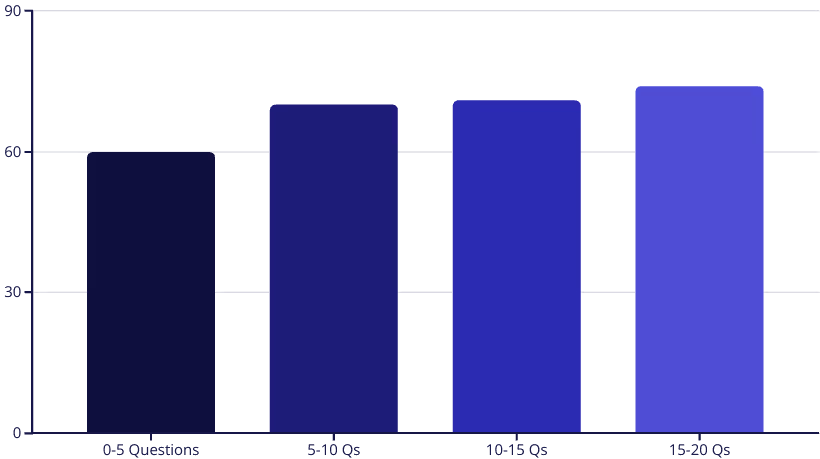
The data suggests that employees value the opportunity to provide detailed, qualitative feedback and engage more deeply with well-designed review processes.
Key Findings
Too Few Questions
Reviews with 5 or fewer questions saw the lowest review completion rates, indicating that too short can be considered insufficient.

Optimal Range of Questions
Review completion was highest with 15-20 questions, indicating employees will invest time in reviews they find valuable.

Goal Completion Sweet Spot
Goal completion peaks when review forms have 10-15 questions, suggesting focused, well-structured reviews drive better outcomes.
Review Completion Rate
The Impact of Long-Text Question
Finding the right balance of open-ended questions significantly impacts review completion rates.
Open-ended questions create meaningful dialogue and increase reviewer investment, but too many can cause form fatigue.

Key Findings
≤2 Questions
Forms with two or fewer long-text questions see significantly lower completion rates

3-5 Questions
The sweet spot for long-text questions yielding highest completion rates

27% Completion Boost
Forms with 3-5 questions have a 27% higher completion rate vs. forms with 2 or fewer questions.
Goal Setting
Impact on Goal Completion Rates
How many goals should each employee set?
When employees set more goals, their goal completion rate goes up significantly. Employees that set 20-30 goals per year finish 38% more of their goals than employees that set 5 or fewer.
This shows that a well-defined goal setting process helps employees stay focused and get more done, and having too few goals may not provide sufficient structure or motivation for employees to engage with the performance management process.

Employees that set 20-30 goals per year finish 38% more of their goals

Qualitative Feedback
Feedback Culture and Employee Engagement
PerformYard allows employees to send qualitative feedback comments to any employee at any time. These qualitative feedback comments are different from eNPS and Employee Satisfaction surveys, but there are interesting findings related to how cultures in which employees give a lot of qualitative feedback may not be cultures in which employees have the highest satisfaction scores.
Optimal Feedback Volume
For companies with 250+ employees, employee satisfaction scores are highest when 20-40 people give qualitative feedback comments. This suggests that quality, not just quantity, matters in feedback processes.
Diminishing Returns
When over 200 people provide qualitative feedback comments, there's a 12% drop in employee satisfaction scores. This indicates that excessive feedback can be counterproductive.
eNPS Impact
For larger companies, eNPS scores peak when about 60 people give qualitative feedback but drop significantly when feedback comes from 150-160 people, suggesting too much feedback can be overwhelming.
Constructive Performance Management
Employee Satisfaction & Long-Term Performance
Regular and constructive performance management directly impacts employee engagement, which drives business success through enhanced customer satisfaction, improved retention rates, and increased revenue.
- Year 1: Baseline employee satisfaction scores established when organizations begin using PerformYard.
- Year 2: Continued use and tracking of employee satisfaction metrics.
- Year 3: Ongoing measurement and improvements in engagement and satisfaction.
- Year 4: Employee satisfaction scores are 7% higher and eNPS 6.5% higher compared to Year 1 measurements.

Streamlining the Process
Time to Complete Reviews
PerformYard streamlines the review process, enabling companies to allocate their limited time and resources to more direct person-to-person feedback and coaching. This reduction in review time can lead to increased productivity and employee satisfaction within the organization.
See how PerformYard's streamlined review process saves time.

Year 1 Baseline
Average review time upon adoption of PerformYard

Year 2 with PerformYard
19% faster time to complete reviews vs Year 1

Year 3 with PerformYard
11% faster time to complete reviews vs Year 2
28% faster time to complete reviews vs Year 1
Consistent Performance Management
Goal Completion Rates Improve Over Time
Long-term PerformYard users see dramatic improvements in goal attainment rates. Companies in Year 3 of PerformYard have a 36% higher goal completion rate than companies in Year 1 of PerformYard.
By Year 4, companies see 60% higher goal completion rates. Consistent performance management creates a compounding effect.

Year 1: 72% Goal Completion Rate
First year with PerformYard. Beginning the performance management journey

Year 2: 73% Goal Completion Rate
Slight improvement as processes stabilize

Year 3: 78% Goal Completion Rate
8% higher than Year 1

Year 4: 92% Completion Rate
27% higher than Year 1
Industry & Company Insights
Our data reveals critical performance management patterns across different industries and organization sizes.
This analysis covers how company characteristics influence engagement, satisfaction, and performance outcomes.

Finding Balance
Manager to Direct Report Ratios
For every additional 5 direct reports per manager, the eNPS score declines by 2%. Companies with 0-5 direct reports per manager have a 7% higher eNPS score than companies with 15+ direct reports per manager.
High-Turnover Industries
Companies in high-turnover industries (40%+ annual turnover) have 6.5 direct reports per manager, which is 15% higher than the 5.6 in low-turnover industries (20% or lower annual turnover).
According to the Center for American Progress, replacing an employee can cost up up to 213% of their annual salary. The more senior an employee, the higher the turnover costs.
Impact on Goal Completion
For companies where managers have 20+ direct reports, the average goal completion is 60%. For companies with lower manager-to-direct report ratios, the goal completion rate is 79%.
This significant difference highlights the challenges associated with managing a large team, where managers may struggle to provide adequate support and guidance to employees.
Employee Engagement
Impact of Manager-to-Direct Report Ratio on Employee Engagement
Manager span of control directly impacts employee engagement metrics. Our analysis reveals a clear correlation between smaller teams and higher engagement scores.

Key Findings
Declining Engagement
For every 5 additional direct reports, eNPS scores decline by approximately 2%.

Optimal Team Size
Companies with 1-5 direct reports per manager have 7% higher eNPS scores than those with 15+ reports.

Quality Interactions
Smaller teams enable more meaningful feedback and personalized development opportunities.
Finding Balance
Manager-to-Direct Report Ratios
Finding the right span of control for managers directly impacts performance outcomes and goal completion rates.
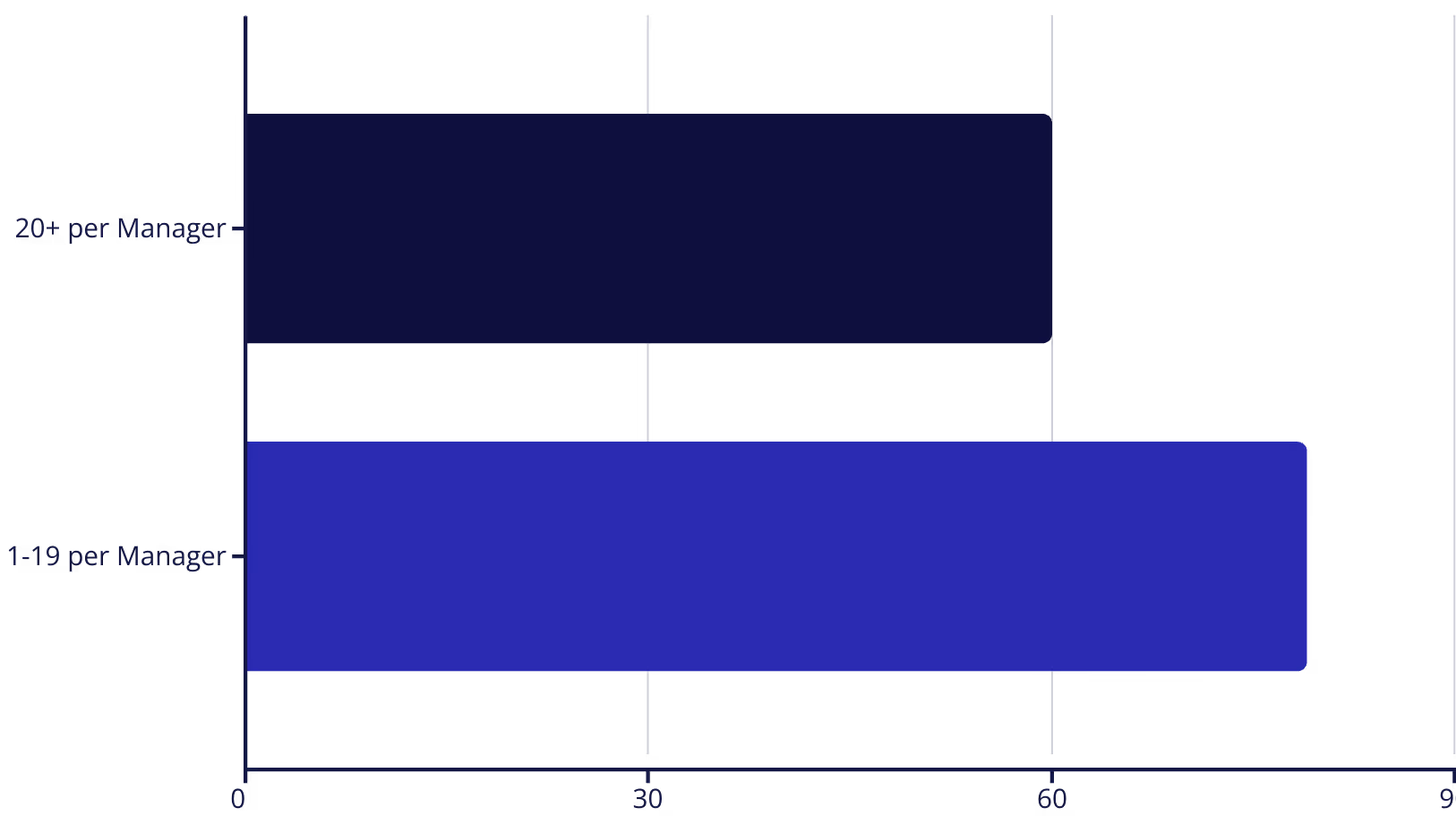
Key Insights
Use of Open-Text Questions by Industry
Qualitative Reviews
(Most Open-Text Questions)
- Apparel & Fashion
- Restaurants
- Utilities
- Research
- Religious Institutions
Common themes:
- Subjective assessments of creativity and customer service
- Detailed explanations of safety procedures
Quantitative Reviews
(Fewest Open-Text Questions)
- Human Resources
- Biotechnology
- Banking
- Pharmaceuticals
- Marketing & Advertising
Common themes:
- Compliance and standardized procedures
- Data-driven metrics and measurable outcomes


Key Insights
Length of Open-Text Answers by Industry
Qualitative Reviews
(Longest Answer Length)
- Research
- Biotechnology
- Venture Capital
- Pharmaceuticals
- Investment Management
Common themes:
- Knowledge-intensive indutreis that require deep analysis
Qualitative Reviews
(Fewest Long-Text Questions)
- Manufacturing
- Mechanical Engineering
- Construction
- Transportation/Trucking
- Consumer Services
Common themes:
- Focused on task completion rather than deep analysis
Industry Benchmarks
Engagement and eNPS Scores
The chart below displays the average eNPS (employee net promoter) scores across various industries. It highlights the differences in employee engagement and satisfaction levels based on industry benchmarks.
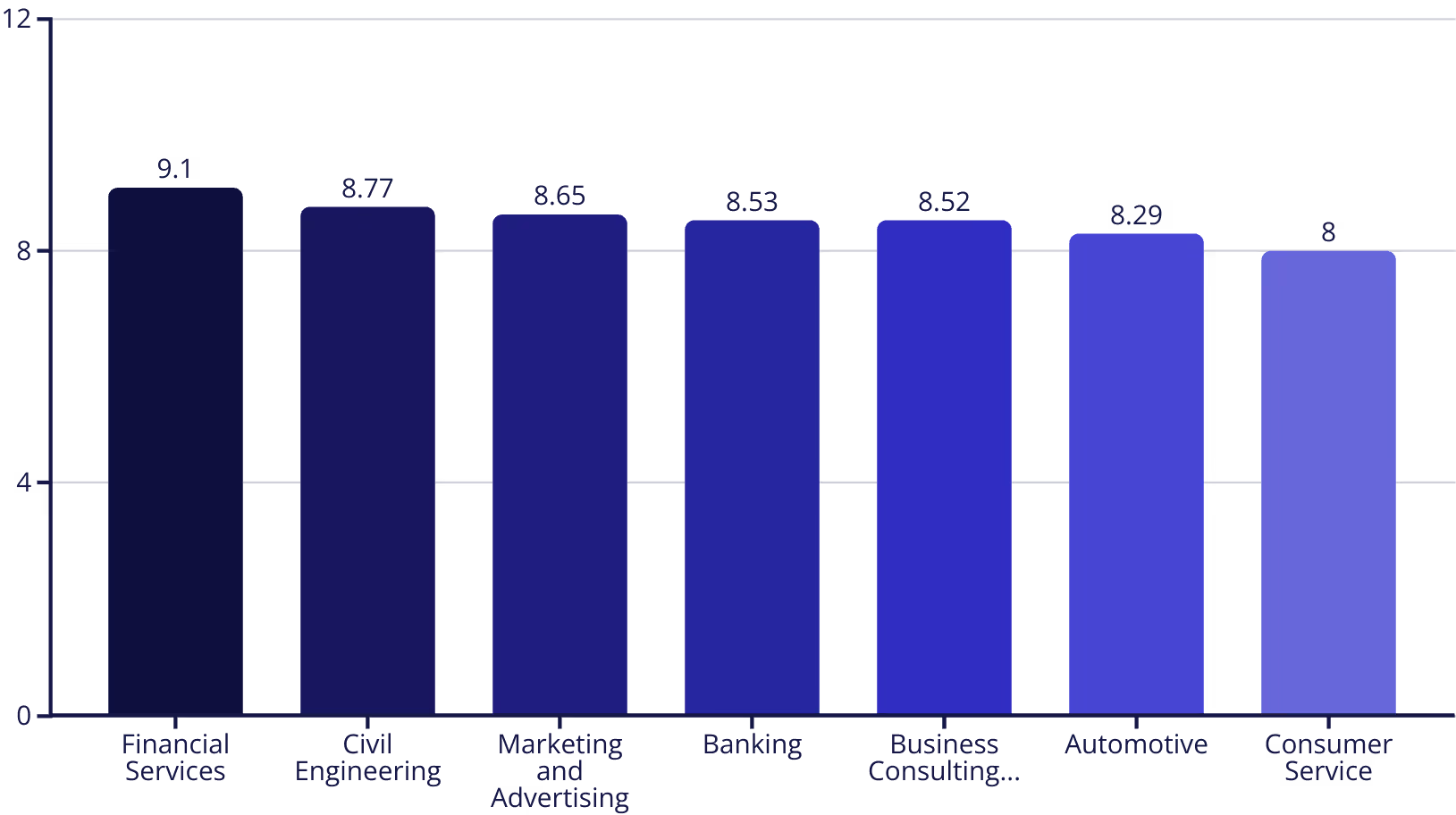
Outpacing Industry Averages
PerformYard Clients’ Headcount Growth
Companies using PerformYard consistently outpace industry averages in year-over-year headcount growth across many sectors.
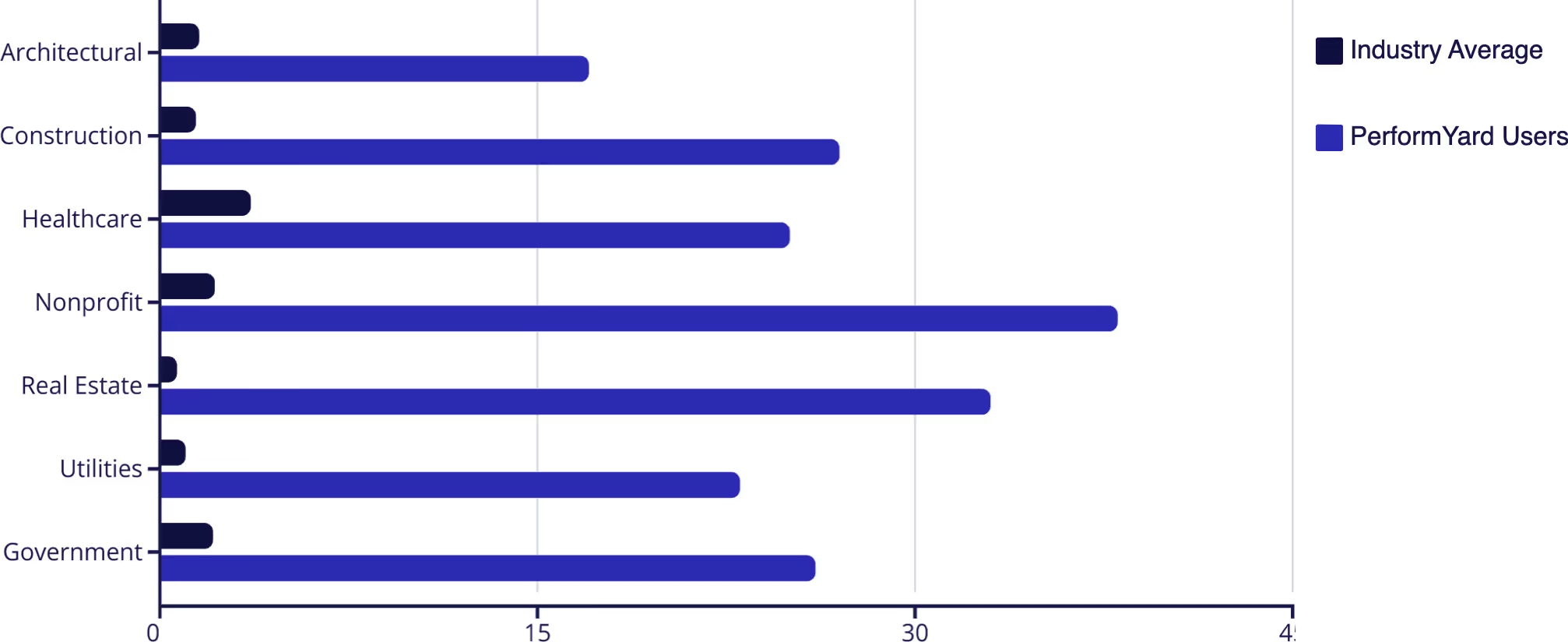
Supporting Scalable Performance Management
Cumulative Average Headcount Growth with PerformYard
Companies using PerformYard experience a consistent increase in the average number of users and annual growth, as highlighted in the chart.
The data illustrates PerformYard's role in supporting scalable performance management processes, which can lead to organizational expansion and success. The growth showcases the platform's ability to create a thriving work environment conducive to scalability and success.
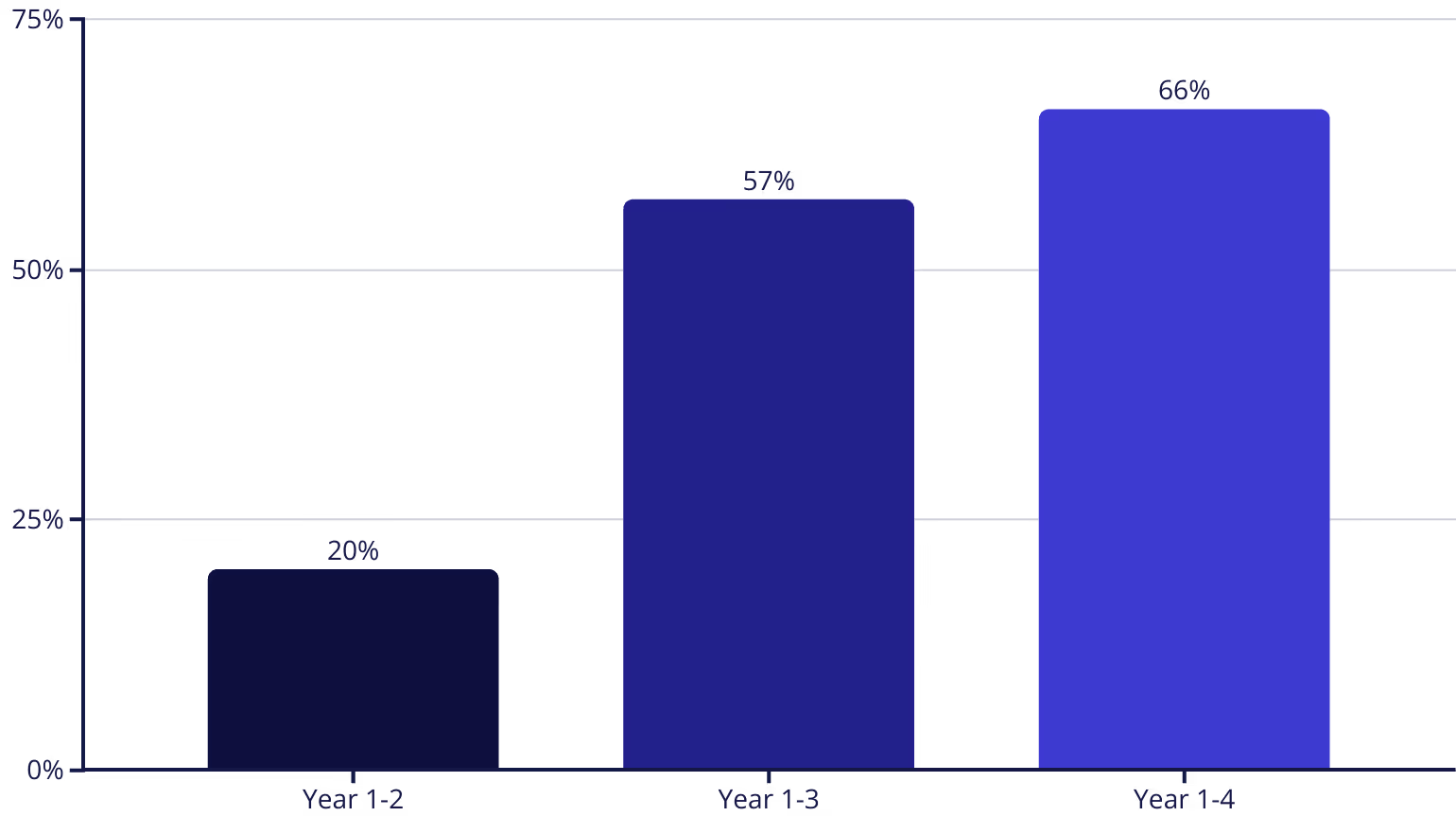
Optimizing Performance Management
Company Size and Employee Satisfaction
Understanding these patterns can help organizations optimize their performance management approach based on their size and growth stage.
Large Companies (750+ Employees)
Highest eNPS scores
Large companies benefit from greater resource availability, established career paths, and organizational stability.

Company size significantly influences performance management practices. Larger companies tend to have higher satisfaction and eNPS scores, potentially due to greater resource availability, established career paths, and organizational stability.
Mid-Size Companies (100-250 Employees)
Lowest eNPS scores

Employee Engagement
Company Size and eNPS Score
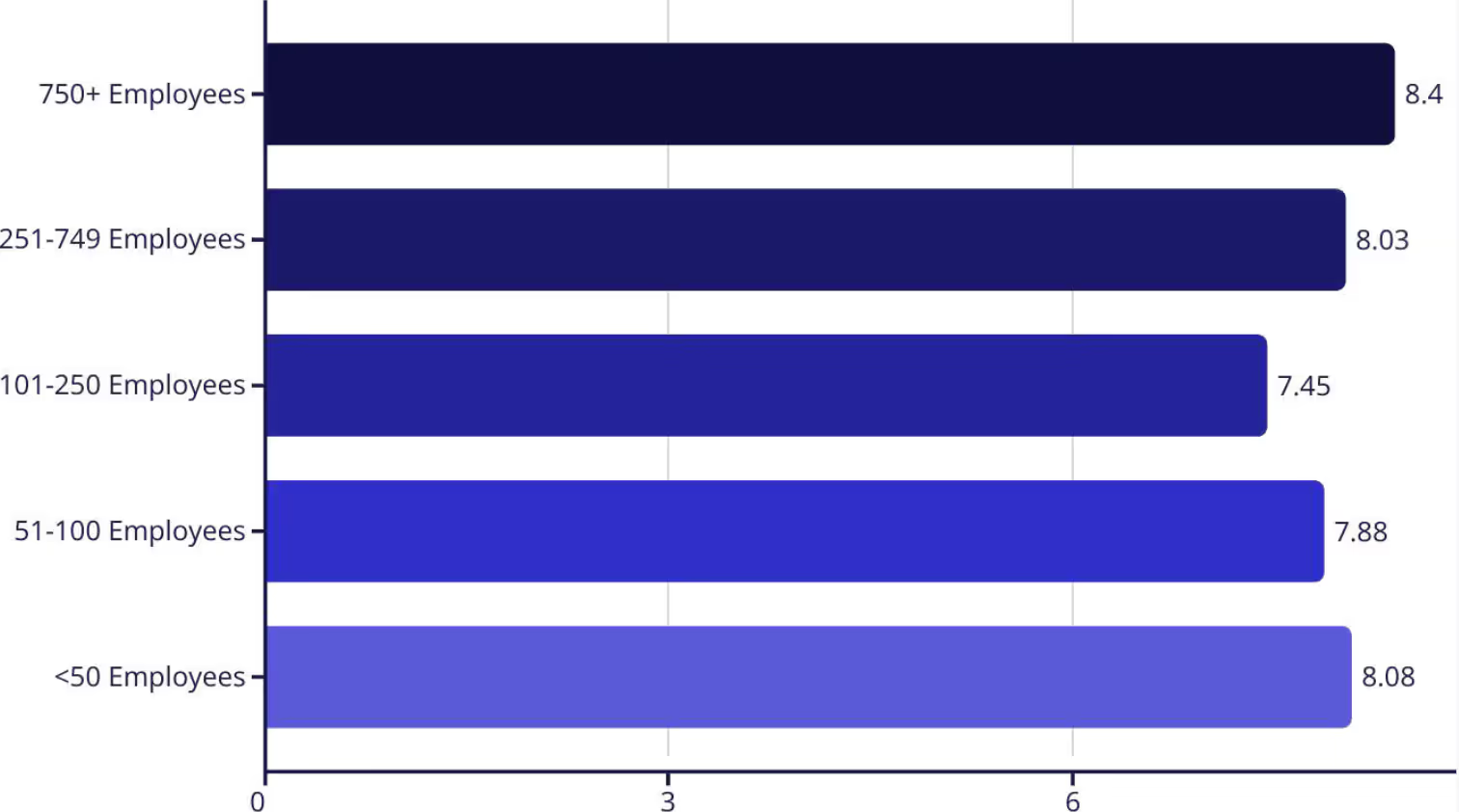
- Mid-size companies (101-250 employees) experience the lowest engagement scores
- Large enterprises (750+ employees) enjoy the highest
Companies in the growth phase of 101-250 employees often face unique challenges that impact employee satisfaction, including evolving management structures, communication breakdowns, and role ambiguity. These organizations typically outgrow informal processes but haven't yet developed robust HR systems. Additionally, mid-size companies often struggle with maintaining company culture during rapid expansion, creating tension between early employees and newer team members.
In contrast, larger organizations benefit from established career paths, comprehensive benefits, and formalized performance management systems. Small companies (<50 employees) maintain relatively high engagement through close-knit cultures and direct access to leadership, despite having fewer resources than their larger counterparts.
Company Size
Number of Forms per Review
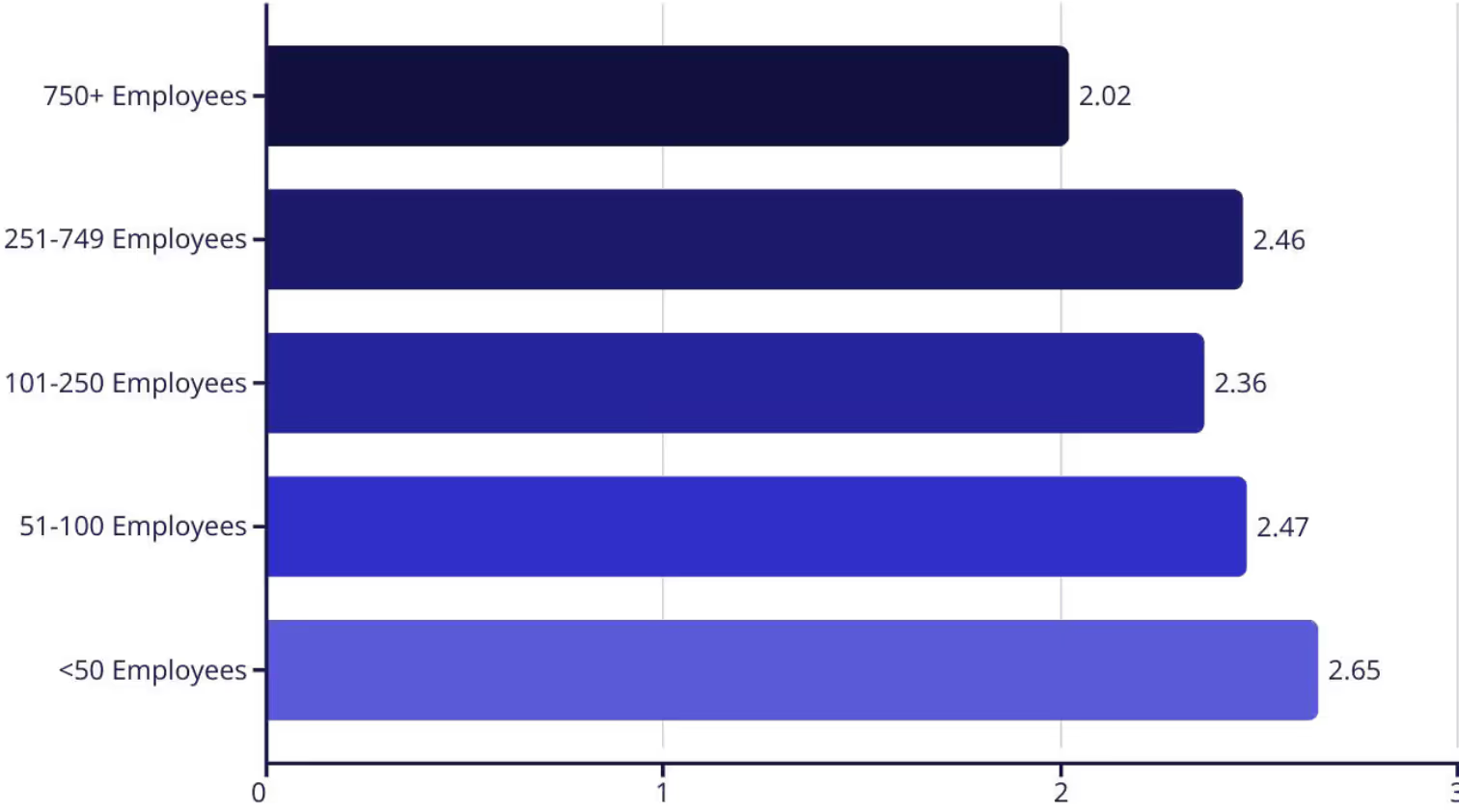
A review with multiple forms may contain a self-assessment, a 360-feedback form, a form related to goals, and other types of forms. Large companies tend to keep review forms to a minimum, while smaller companies add multiple forms to each review.
Small Companies (<50 employees)
Highest forms per review cycle
Most goals set per employee
- Flexible, hands-on approach
- Direct leadership involvement
- Ambitious goal-setting culture
Large Enterprises (750+)
Fewest forms per review cycle
Fewest goals set per employee
- Streamlined documentation practices
- Stadardized performance frameworks
- Focus on strategic alignment
Key Findings
The Sweet Spot for Goals and Informal Feedback
Effective performance management is about quality over quantity
- 10-15 Questions Per Review
Lead to Highest Goal Completion Rates- Employees appreciate the opportunity to think deeply about their work and provide comments during reviews
- 20-40 Informal Feedback Sources
Is Ideal for Larger Companies- If you find that you have over 100 people providing feedback comments, there may be an employee satisfaction issue
- 3-5 Long-Text Questions Per Review Form
Yields the Highest Review Completion Rates- Employees are more than willing to answer questions that require written responses
Key Findings
Long Term Benefits of Performance Management
Consistency yields compounding returns
- Companies who have been with PerformYard for 3+ years experience Year-over-year increases in goal Completion rates, review completion rates, and headcount growth.
- Organizations that invest in performance management software show their employees that they care about performance, growth and feedback, helping to deliver a winning culture.
- For PerformYard clients, organizational growth outpaces industry averages
- Companies that use PerformYard grow, on average, 60% from Year 1 to Year 3. Many companies are greatly exceeding industry benchmarks for headcount growth.
Key Findings
There Is No One-Size-Fits-All Approach
Tailored reviews reflect different needs based on industry and company size.
- Industries tailer review length, question type, and answer lengths to their
specific needs
- Smaller companies tend to have longer reviews and more goals per employee
- Larger companies tend to have shorter reviews and fewer goals, but also have the highest employee satisfaction scores
- Large companies and small companies have higher employee satisfaction scores than mid-sized companies
- Rapid company growth may trigger a reduction in employee satisfaction
Frequently Asked Questions
Get answers to common questions about our 2025 State of Performance Management Report.
How was the data for this report collected?
The data in this report comes from over 2,000 companies of all sizes and industries. It includes anonymous info on growth, turnover, and performance practices, showing clear patterns based on how long companies have used PerformYard.
How often is this report updated?
The State of Performance Management report is updated every year to share the latest trends, tools, and ideas. This helps teams stay up to date with innovations from recent years and make better decisions about how they manage performance.
Can I share this report with my team?
Yes! You can share the State of Performance Management with others. If you download the full report, feel free to share it with your team. We hope you use the ideas in the report to help improve performance management at your company.
How can I implement these findings in my organization?
You can start by reviewing the key takeaways and seeing which ones match your current challenges. Focus on one or two areas, like improving review formats or setting clearer goals. Then, work with your team to test small changes and track the results. Over time, we believe these updates can lead to better performance and higher engagement.
How do I get started with PerformYard performance management software?
Getting started with PerformYard is easy. The best way to learn how it can work for your team is to see it in action. Sign up for a free demo to explore the platform, ask questions, and see how it can help you simplify reviews, set better goals, and boost employee engagement.

_min.webp)



